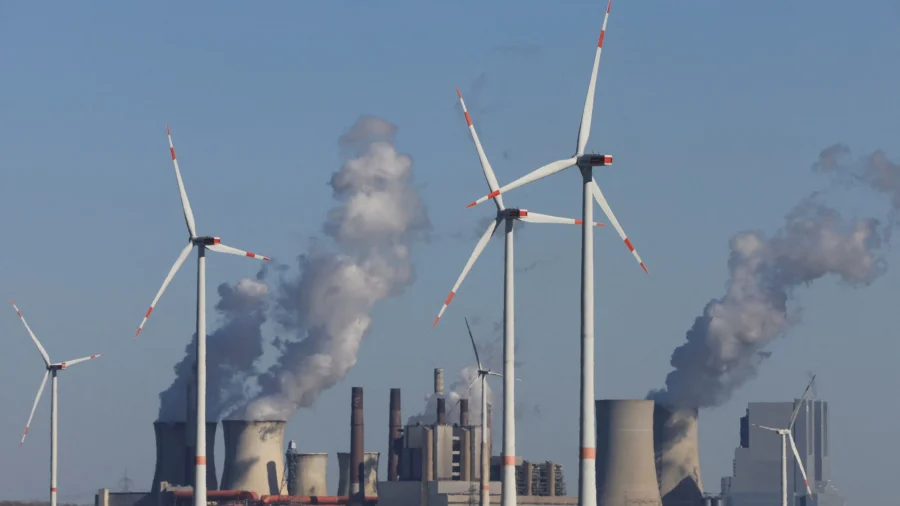Germany is bringing back some of its coal power plants online ahead of the winter season amid concerns about a potential shortage of natural gas supplies.
Germany has cracked down on its coal power plants as part of transitioning out from fossil fuel energy. However, as the Russia-Ukraine war dented gas supplies from Moscow and nuclear power supplies from France got affected, Berlin last year decided to keep 1.9GW of lignite coal power online. Lignite, referred to as brown coal, is the lowest grade of coal. On Oct. 4, the German government announced that lignite coal plants would remain on standby into the winter, until the end of March 2024. This is expected to help offset the scarcity of natural gas during the season.
“The supply reserve will be reactivated in order to save gas in electricity generation and thus prevent supply bottlenecks with gas in the 2023/2024 heating period,” the government said, according to media network Euractiv.
The decision is expected to keep the price of electricity down by around 0.4 euros per Megawatt-hour (MWh) to 2.8 euros per MWh.
Despite the recent developments, the German government remains adamant in its commitment to phasing out coal-fired plants completely by 2030, and becoming carbon-neutral by 2045.
Germany already has 45GW of coal power plants. The latest decision will keep an additional 1.9GW of lignite capacity ready to meet any immediate energy needs.
The government issued an order to allow the renewed activation of coal power units under energy firms LEAG and RWE AG on Wednesday.
The order will affect two coal blocks from RWE and two from LEAG. These facilities were operational during the last winter season and were placed on standby in July this year. The order will now reactivate these units.
Germany’s Energy Woes
Even as the reactivation of a few coal units adds to Germany’s energy security, the country phased out its last remaining nuclear reactors earlier this year, which will tighten the power supply during the winter.
The nuclear plant shutdown, which occurred in April, had attracted strong criticism due to the country’s ongoing unstable power supply situation. On April 14, a group of scientists, including two Nobel laureates, called on the government to reverse its decision.
“In the past, other European countries also pursued plans to reduce their nuclear power generation capacities. In recent years, however, many of these countries have taken a different stance on nuclear power due to rising energy costs, which has been exacerbated by the most recent loss of Russian natural gas deliveries,” the scientists said in an open letter.
Berlin’s decision to reopen coal plants while shutting down nuclear facilities was criticized by Robert Roos, a Member of the European Parliament (MEP) from the Netherlands.
“Germany is ruled by ‘green’ radicals. They base their policies on ideology. Ditches 17 perfectly functioning clean nuclear reactors, the last of which even during the energy crisis,” he said in an Oct. 5 post on X.
“Their energy policy is a disaster for citizens, for companies, and for the German economy. In the meantime, they are imposing this devastating energy policy on the rest of the EU.”
Germany is currently seeking to fill its energy shortage by constructing additional LNG infrastructure. The country also plans to build gas-powered plants that could later be converted to hydrogen.
The government is weighing whether to extend operations of two RWE lignite power units until spring 2025.
In the first quarter of 2023, the country generated 22.2 Terawatt-hour (TWh) of coal-generated power, which was the lowest ever output, far below the more than 60 TWh generated eight years ago during the same period.
US, China Coal Situation
Like the German government, the United States is also implementing anti-coal policies under the Biden administration.
In April, the U.S. Environmental Protection Agency (EPA) proposed rules that would tighten emission restrictions on coal-fired plants, triggering worries about cost and feasibility in the industry.
Lignite coal plants could face a 70 percent cut in their emissions limit for mercury under the proposed rule. In addition, the emission limit for filterable particulate matter could be reduced by two-thirds. This move is supposed to address hazardous pollutants coming from the plants, per the agency.
The lignite plants also have to use continuous emission monitoring systems to ensure compliance with these new limits.
In an interview with The Epoch Times, Dan Kish, a senior vice president for policy at the free market American Energy Alliance, slammed the proposal, saying that its goal is “to make electricity prices higher, as are all their energy policies.” He called the EPA proposal “legal abuse.”
Conor Bernstein, a spokesperson for the National Mining Association, said that the rule fits with the broader efforts to limit coal use by the EPA.
“The cumulative effect of the EPA’s agenda is a less reliable and increasingly expensive supply of electricity as the nation continues to struggle with energy-driven inflation,” he said.
While governments in the United States and Europe are taking steps to curtail the use of coal, China—the single largest emitter of greenhouse gasses in the world—is moving ahead with its coal projects.
According to a February report by the Global Energy Monitor and the Centre for Research on Energy and Clean Air, coal power construction starts, new project announcements, and plant permissions “accelerated dramatically” in China last year—with two new coal power plants being permitted per week.
“50 GW of coal power capacity started construction in China in 2022, a more than 50 percent increase from 2021. Many of these projects had their permits fast-tracked and moved to construction in a matter of months,” the report said.
“A total of 106 GW of new coal power projects, the equivalent of two large coal power plants per week, were permitted. The amount of capacity permitted more than quadrupled from 23 GW in 2021.”
From The Epoch Times


